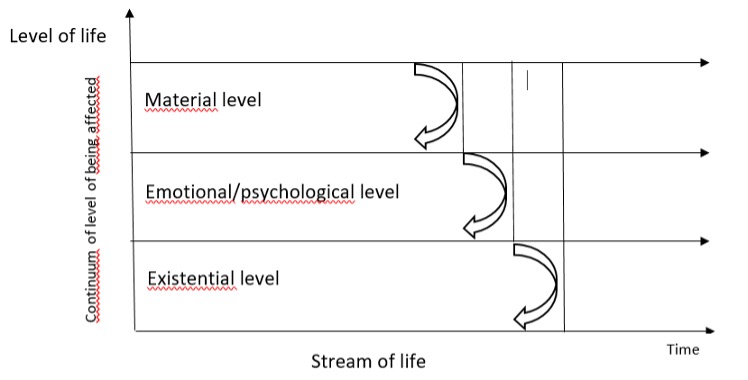Everything begins with listening! If you want to truly understand your neighbor, stop talking and start listening. With that comes the art of asking the right questions at the right moment. The right question is engaging, powerful and focuses on opportunities, possibilities and responsibilities. Whether we have a start-up meeting, a problem-solving meeting or a restorative conference, the right question is the question that triggers the conversation that matters at that moment.
With the Restorative Questions we have arrived at the upper level of the Prevention Pyramid (part 1, chapter 5). This means they are specifically intended to deal with situations that have escalated toward an open conflict. Before we explain the RQs and how they can be used we will share another interesting framework that explains why dealing with conflict is so extremely important. It is a model also developed by criminologist dr. Johan Deklerck: “the stream of life”.
The stream of life

Deklerck compares life to the flow of a river. Within this river, he distinguishes three levels of life: the material level, the emotional-psychological level, and the existential level.
Interruptions can occur at each of these levels. An incident or conflict then causes a (temporary) stop in the flow of life. Compare it to a dam that prevents the water from flowing. The more serious the incident, the more fundamental the stoppage of the life flow.
Almost daily, we face small or larger interruptions of a material nature. For example: you come back home from the supermarket with plenty of bags in your car and you notice someone has parked illegally in front of your garage. This is briefly inconvenient. You have to park further down the street, walk a few times up and down with your groceries, and maybe you try to track the driver down or you put a small note under the windshield of the car expressing your frustration. This is not a traumatic experience, and you quickly forget about the incident.
Some situations can affect us on what Deklerck calls the emotional-psychological level. For example: When you leave for work in the morning you notice the side window of your car is smashed. Someone broke into your car and stole some small change that you had left there inattentively. You report the incident to the police and the insurance company. You call your car mechanic to get the window fixed. But mostly, you are left feeling miserable. You never thought this would happen in your neighborhood. You wonder who is responsible for this deed. You keep worrying about it, although you’ll never get the answers to your questions. It takes a while before you regain your trust and fully recover from this incident.
Damage can also occur at an (ethical-)existential level. Sometimes a person is so deeply affected by an incident that they are barely able to resume their normal course of life. Time seems to stop. The flow is completely blocked. For example: a 70-year-old woman goes out for a walk with her dog in the evening and gets robbed. Two offenders approach her from behind. She gets pushed to the ground and they rob her of her purse. The offenders were never caught. The incident continues to haunt the lady for years.
Often, such impactful events permanently divide time into a “before” and an “after.” If we fail to break through the barrier, to remove the blockage in our stream of life, the water will seek its own path. Our pain goes underground, but it will continue to affect us in our daily functioning. By focusing on material, emotional, relational, or existential damage, restorative practices help to remove obstructions, allowing us to fully reenter the flow of our life.
Dealing with conflict decisively through the use of restorative practices will help us regain our freedom. The so-called Restorative Questions are an excellent tool in making this possible. They form the backbone of any responsive, restorative conversation. Whether it’s a preparatory conversation (assessment) with one of the parties, a restorative dialogue (with two parties), a restorative circle with multiple parties, or a formal restorative conference, these questions always help with structuring the conversation. We will review them one by one in the downloadable document.






